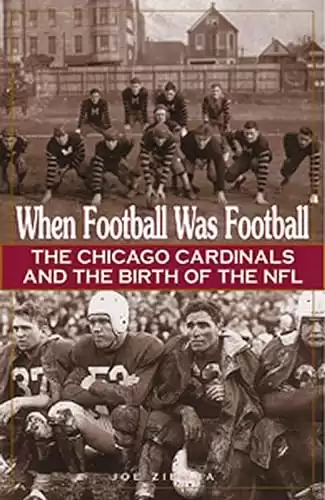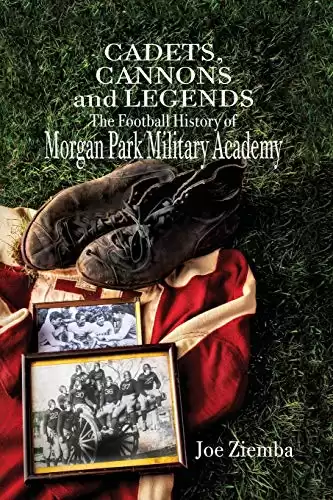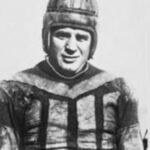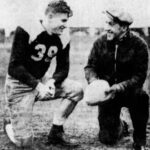Every so often, an NFL team strikes gold with a draft choice. In 2022, virtually no stone is left unturned when teams belly up to evaluate potential draftees. Film, personal workouts, sprint times, psychological profiles, and personal interviews are all considered as part of the process to determine which players will be identified as probable draft prospects. After all, big, big money is at stake along with the future success of the selecting team.
But when the draft was initiated in 1936, many of the draftees simply were not interested in pursuing professional football. This prompted teams to begin looking at prospects with a little more scrutiny instead of simply relying on newspapers or football magazines to learn about the top prospects. Or in many cases, a bit of luck was involved…
Less study was required for the Chicago Bears in 1940 when a fairly well-known, although smaller player, was a draft day objective of the team. He was selected as the second pick in the first round of the 1940 draft by the Philadelphia Eagles but eventually enjoyed such a stellar career with the Bears that owner George Halas once said: “The highest compliment you can pay any ball carrier is to just compare him to George McAfee.”
Of course, McAfee is now a member of the Pro Football Hall of Fame, but how did Halas manage to finagle his rights from the Eagles? The boss man of the Bears was known for his shrewdness around draft time as exemplified in 1936 when he secured the rights to Heisman Trophy winner Jay Berwanger from the University of Chicago, also from the Eagles.
Halas Secures Rights to Berwanger
In the case of Berwanger, Philadelphia owner Bert Bell felt that Berwanger, who was the first draft pick ever in the National Football League, was simply unwilling to play professional football unless he was the recipient of an enormous contract. Rather than risk losing the value of his first-round draft choice, Bell traded the rights for Berwanger to the Chicago Bears in exchange for veteran tackle Art Buss.
Although Halas and Berwanger were never able to reach an agreement, the fact that Halas was able to maneuver the best player in college football onto his shipload of prospects was certainly intriguing.
As the years went by and teams began to take the draft much more seriously in terms of preparation, Halas worked his back-room magic again when acquiring McAfee in 1940. McAfee had been an All-American halfback at Duke where his blazing speed (9.7 in the 100) made him an immediate threat on both offense and defense.
He was a dynamic baseball player at Duke and also ran track, winning the Southern Conference 100-meter dash championship as a senior in 1940. As a runner, Duke football coach Wallace Wade described McAfee as “a one-man offense, and practically unstoppable.”
That Kid Will Get Killed!
As such, Halas engineered a quick trade with the Eagles to acquire McAfee in a move that was likely pre-arranged before the 1940 draft. In exchange for the rights to McAfee, the Eagles received three players. Apparently, Halas was unaware that McAfee was a few pounds shy of 170 when he reported to his first Bears training camp in the summer of 1940.
The Coffin Corner magazine, published by the Professional Football Researchers Association, suggested that Halas may have initially feared for the safety of his newest acquisition: ‘When the Bear owner first saw McAfee [in training camp] he must have wondered whether the reed-thin 165-pound halfback would last in the NFL. The answer came in a practice scrimmage.
Quarterback Sid Luckman called a dive play for McAfee and the linebacker saw it coming. ‘Oh, oh,’ moaned Halas, ‘that kid will get killed!’ But, the kid zipped into the hole on one side and the linebacker crashed in on the other. The kid gave the linebacker a leg, took it away, and was gone. The linebacker lay in the hole with the dirt he tackled. “I think we’ve got something here!’ said Halas.”
Indeed, he did! McAfee’s blinding speed and his elusive moves quickly earned him the nickname of “One-Play McAfee” since the possibility was always there that McAfee could score from anywhere on the field at any time and at any position.
It was in that first training camp in 1940 that McAfee developed his own personal philosophy while serving as one of the smaller running backs in the NFL: “I never saw so many big men in my life! I remember clearly, on one of the first scrimmage plays, that a rookie halfback was knocked cold trying to bring down Bill Osmanski.
That play served as a valuable lesson for me. Whenever I ran with the ball, I had that picture in my mind of that halfback there on the ground, cold as a stone. [I decided] I would run as fast as I could if there was any daylight.”
He Puts The Defense Off Balance
Aside from his dazzling speed, McAfee utilized a unique running style that incorporated a variety of fakes, feints, and misdirection to bewilder opposing defenders. Chicago Cardinals head coach Jimmy Conzelman referred to McAfee’s signature move as a “hip shaft.” Conzelman stated: “That’s something few really fast players ever developed. He puts the defense off balance and fakes with his head as well as his arms and body.”
It did not take long for McAfee to impress the rest of the National Football League as well. In his first regular season game at Green Bay on September 22, 1940, McAfee superbly engineered the Bears convincing 41-10 win over the Packers. He scored two touchdowns and passed for a third in a performance that shocked, let’s make that stunned, reporter Henry McCormick of the Wisconsin State Journal.
In his game coverage, McCormick went straight to the point by noting: “If you want to describe the Packers’ trouble here Sunday afternoon in a couple of words you should not have any trouble. The two words are: George McAfee.”
Basically, McAfee put the entire league on notice with the result of his first “touch” of the ball in his young career. After an opening Green Bay field goal, McAfee brought back the ensuing kickoff 93 yards to provide the Bears with the lead that they would never relinquish.
The long kickoff return was certainly impressive, but it was the way that McAfee did it that knocked McCormick’s blushing, laudatory coverage into the stratosphere:
Tackler Was Covered In Confusion
“Paul Engebretsen’s long boot sailed straight at McAfee. He gathered it on his own five-yard line, and then he turned on the greatest piece of running this writer has seen. As the onrushing Packers started closing in, McAfee suddenly veered sharply to his left.
McAfee had the Packers falling all over themselves for a few seconds here as he cut, reversed his field, gave them a leg, and took it away, and any of the other tricks ever devised to get a ball carrier through a broken field. There was one tackler directly in McAfee’s path. He threw one feint and gave him another just to make his confusion complete. While the tackler was covered in confusion, McAfee went by him like a streamliner train running behind schedule.”
Later in that same game, McAfee scored on a 15-yard run and tossed a seven-yard touchdown pass to receiver Ken Kavanaugh. Oh yes, McAfee also played tight defense, returned kicks, and did the punting for the Bears.
Called The Bears Crybabies
While the Chicago Bears were not especially dominating in 1940, the club finished 8-3 and won the western division, qualifying to meet the Washington Redskins for the NFL championship. The two teams had met once before during the regular season when Washington edged the Bears 7-3 on November 17, 1940.
The Bears vigorously protested the ending of that game when it was felt that an obvious pass interference play in the end zone was not called against Washington costing the Bears the game. Following these complaints, Washington owner George Preston Marshall blasted the losers, calling them “crybabies” among other creative nouns and adjectives.
George Halas, being the master motivator, collected all of the printed examples of Marshall’s criticism of the Bears and pasted them all over the Bears’ locker room prior to the title game. The result: the Bears hammered the Redskins 73-0 in what remains as the most lopsided defeat in NFL history, as well as the most points scored in one game.
In that contest, McAfee returned an interception 35 yards for a score in the crushing rout of Washington. He later recalled: “My biggest game was that 1940 championship. The Redskins had beaten us 7-3 three weeks before in Washington. To come back and beat them 73-0 for the championship was a great thrill.”
Is McAfee As Good As Thorpe?
Following the 1940 season, New York Times columnist John Kieran wrote: “The debate around Chicago has been as to whether McAfee is just as good as Jim Thorpe ever was, or even better!” It was high praise indeed for the slight halfback, who also pioneered the use of “low-cut” football cleats while on the field.
However, McAfee was even better in 1941, topping the NFL with 12 touchdowns, including six rushing, three via receptions, and one each for a punt return, kick return, and an interception. He also picked up 474 yards on the ground (7.2 yards per carry), grabbed seven passes for 144 yards, picked off six passes, and did the kick returns and punting for the Bears. He was an obvious choice as a first-team All-Pro.
Like so many of his NFL brethren, McAfee volunteered for the military during WWII in 1942. He missed three full seasons from 1942-1944 but returned for the final three games in 1945. George Halas was hesitant to use McAfee upon his return in 1945 after such a long layoff, noted the Coffin Corner:
“’ Take it easy, George,’ Halas warned, ‘You’re not ready to play.’ ‘I understand, coach,’ said McAfee. He then ‘exercised’ for 12 minutes, running the ball only five times. The result was 105 yards and three touchdowns.”
There's Never Been A Better Open-Field Runner
Unfortunately, a knee injury limited McAfee to three games in 1946. The injury cost McAfee some of his outstanding speed but he still made an impact in 1947 rushing for 392 yards and adding 17 receptions for 227 yards. Overall, he tallied eight touchdowns and the legendary Red Grange remained amazed at the capabilities of McAfee in 1948:
“In my book, there’s never been a better open-field runner. When you see him in slow-motion movies, his maneuvers are incredible. He jumps every which way and every muscle seems to be going full blast like the guy is on fire.
I remember a Bear film that shows George feinting around a tackler by hopping three times on his left foot. Then, without a loss of balance or speed, he came down on his right foot and was gone!”
McAfee finally retired from football in 1950 and the Pro Football Hall of Fame came calling in 1966. During his eight-year career, McAfee scored 234 points and compiled 5,313 combined net yards. He also intercepted 25 passes and held seven Bears’ offensive records when he left the game.
According to The Football Database, McAfee still holds the NFL record for the best punt return average of 12.8 yards per return—this over 80 years after McAfee began his NFL career. And of course, he was part of three NFL championship teams with the Bears in 1940, 1941, and in 1946.
Following his retirement, McAfee served as an NFL official for several years and also owned a Shell Oil distributorship until 1981. He passed away in 2009 at the age of 90.

McAfee Is Better Than Gipp and Grange!
If we look back at the enormous talent of George McAfee, perhaps we could start, and end, with the wonderful comments from sportswriter Henry McCormick after McAfee’s very first NFL game against the Packers in 1940. McCormick closed his game summary by stating: “The Bears were a good team today.
Maybe they were a better team than the Packers, although you can get an argument on that. But you can’t get any argument on the part George McAfee played in this game. He was the five-star attraction. He stopped the show.”
And we’ll leave you with a final quote from long-time Bears assistant coach Hunk Anderson whose experience in football crossed generations. Anderson simply stated: “I played with George Gipp at Notre Dame and I saw plenty of Red Grange, but McAfee is better than either one of them!”
Thank you, as always, for joining us for this episode of “When Football Was Football” here on the Sports History Network!
Author and Host - Joe Ziemba
Joe Ziemba is the host of this show, and he is an author of early football history in the city of Chicago. Here, you can learn more about Joe and When Football Was Football, including all of the episodes of the podcast.
Please Note – As an Amazon Associate I earn from qualifying purchases
Resources
More From When Football Was Football
Paddy Driscoll’s Almost Perfect Season
Back at the beginning of the National Football League in...
Read More120,000 Fans Witness High School Football Game in 1937!!!
Let’s set the stage… It was a warm November afternoon...
Read MoreIn The Beginning: An Interview With Joseph T. Sternaman
And, you may ask, who is Joseph T. Sternaman? Sternaman...
Read More1948: The Last Hurrah of the Chicago Cardinals
Cardinals’ fans are familiar with the long, sad story concerning...
Read More





2 thoughts on ““One Play” McAfee Still Holds NFL Record Nearly 80 Years Later”